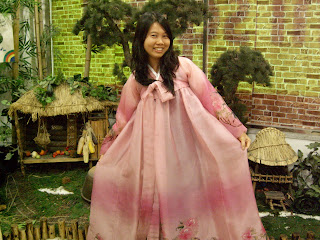When we stepped into the Kimchi School in Seoul, welcoming us were colourful traditional Korean costumes, not vegetables.

We left our belongings in a rack and lined up to let the female employees put hanbok on us. They were the ones who picked our clothes according to our sizes.
When I was small, I danced on the stage in schools in Chinese minorities' costumes and Indian saris. When I was in France, once my language school Vietnamese classmate let me wear her traditional dress aodai and all her fellow citizens were amazed that I resembled a typical Vietnamese. I also had an interesting experience to be dressed in kimono when joining my Japanese friends to sell sushi in the international night and I am still keeping the one my brother bought for me from Japan. Needless to say, as a Malaysian I have cheongsam, baju kurung, baju kebaya and punjabi suit in my wardrobe.
It was the first time I wore the Korean national dress.

I was very comfortable in hanbok which consists of jeogori, a blouse shirt and chima, a wrap-around skirt, which is usually worn full. If I were to wear a traditional costume in my daily life everyday, I would definitely choose this Korean dress as I could still be myself by walking rapidly and making big steps...

Mum with her small eyes and fair skin often received comments that she looked like a Japanese or a Korean.

We two were the only ones in our group to be given dresses in soft pastels which we both liked very much.

After the photograph session, we entered a room for our kimchi making lesson. Our teacher was a sweet lady who explained and demonstrated to us how to prepare the fermented dish with cabbage in a traditional way.

I remembered those days when my Japanese friends taught me to make sushi. I was always excited when attending culinary classes.

Even Mum who was quite tired of cooking recent years seemed to be revived in front of the cabbage and chili paste.

We apprentices' products were packed in plastic bags and sent to the nearby orphanage to bless the children there. Then we ordered kimchi made by real experts of the school to bring back to Malaysia. It was going to be directly delivered to the airport to check in together with our other luggage on the day of our return later.
After this session, now you can count on me to prepare for you some kimchi with our Malaysian vegetables.
3 comments:
I would like to go to Korea to learn more about traditional kimchi making. I already make kimchi but I would like to take some formal classes. Can you please give me the name of the school in Korea or any place where I can go to learn about this art?
I am a Canadian farmer.
Colleen Ross
Iroquois, Ontario, Canada
613-652-1552
www.waratahdowns.com
Hi, Colleen. Thanks for your comment. As a tourist, I have no idea of the name of the school because the itinerary was arranged by the travel agency in Malaysia. Sorry, I can't help you.
hai...Michan..nice to read ur post.. actually my friends and i will going to Korea early November 2011...and one of the places that we may visit is kimchee school at Seoul right.. so basically ur post give me little bit information on what we would do when we arrived there...thanks for the good information..really hope that I will feel the excitement same like you already experienced....wish me luck there....
Post a Comment